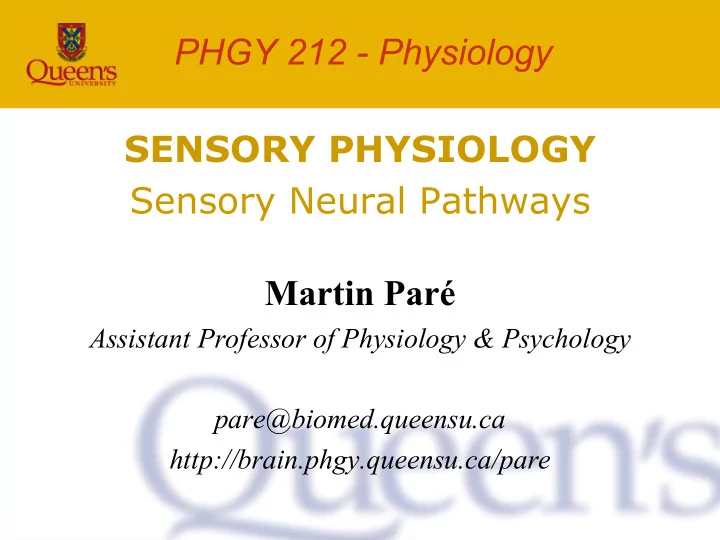

PHGY 212 - Physiology SENSORY PHYSIOLOGY Sensory Neural Pathways Martin Paré Assistant Professor of Physiology & Psychology pare@biomed.queensu.ca http://brain.phgy.queensu.ca/pare
Pathways for Sensory Perception
Pathways for Sensory Perception Primary sensory neurons bring information from somatic receptors to secondary sensory neurons in the CNS.
Pathways for Sensory Perception The location of the synapse between primary and secondary sensory neurons varies according to the type of receptor.
Pathways for Sensory Perception Secondary sensory neurons cross the midline of the body, so that sensations from the left side of the body is processed in the right hemisphere of the brain.
Pathways for Sensory Perception In the thalamus, secondary sensory neurons synapse onto tertiary sensory neurons, which in turn project to the cerebral cortex.
Pathways for Sensory Perception There is one exception to this routing through the thalamus: olfactory sensory neurons project directly to the cerebral cortex.
Spinal Cord The spinal cord has a core of gray matter (neuron cell bodies) and a surrounding rim of white matter (nerve fibers).
Spinal Cord Spinal nerves divide into two branches called roots . The ventral root of each spinal nerve carries information from the CNS to the muscles and glands. Spinal nerve Ventral root
Spinal Cord The dorsal root of each spinal nerve is specialized to carry incoming sensory information. The dorsal root ganglia contain cell bodies of sensory neurons. Dorsal root Ganglion Spinal nerve Ventral root
Spinal Cord The gray matter contains the cell bodies of interneurons. Cell bodies in the dorsal horn form two sensory nuclei receiving somatic and visceral information. Cell bodies in the ventral horn form two efferent nuclei sending somatic and autonomic information.
Spinal Cord The white matter contains axons that transfer information up and down the spinal cord. Ascending tracts that take sensory information to the brain occupy the dorsal and external lateral portions of the cord, e.g., lateral spinothalamic tract.
Spinal Cord Descending tracts that carry commands to effector organs occupy the ventral and internal lateral portions of the cord, e.g., ventral corticospinal tract.
Somatic Pathways Midline Sensory Cortex Thalamus Medulla Lateral spinothalamic tract Dorsal column Ventral spinothalamic tract fine touch, pressure Spinal Cord coarse touch pain, temperature
Somatic Pathways Dorsal column consists of large myelinated axons that carry fine touch information. They cross over at the medulla. Spinothalamic tracts consist of small unmyelinated axons that carry pain, temperature, and coarse touch. They cross over at the level of the spine.
Cerebral Cortex Cerebral cortex contains four lobes linked to distinct functions.
Cerebral Cortex Somatic senses are processed in the primary somatic sensory cortex ( parietal lobe ).
Somatosensory Cortex Sensory receptive fields are orderly organized in somatosensory cortex to form a map of the body: the Homunculus Density of sensory receptive fields dictates in which proportions the body parts are represented Boundaries of this map are not fixed; plastic changes occur.
Cerebral Cortex Taste is processed in the gustatory cortex ( parietal lobe ).
Cerebral Cortex Hearing is processed in the auditory cortex ( temporal lobe ).
Cerebral Cortex Smell is processed in the olfactory cortex ( temporal lobe ).
Cerebral Cortex Vision is processed in the visual cortex ( occipital lobe ).
Cerebral Lateralization The functional areas in the two hemispheres are not symmetrical. Spatial and musical skills are concentrated on the right. Language and verbal skills are concentrated on the left.
Language Spoken and written language are processed through their respective sensory areas. The information is passed to Wernicke’s area, where it is interpreted, then to Broca’s area for the coordination of speech and writing.
Language Damage to Wernicke’s area disrupts language comprehension ( receptive aphasia ). Damage to Broca’s area disrupts language expression ( expressive aphasia ).
Reading Silverthorn (2 nd edition) Silverthorn (1st ed) pages 289 - 290 pages 272 pages 259 - 260 ( spinal cord ) pages 242 - 243 pages 265 - 266 ( cortex ) pages 247 - 248 pages 274 - 275 ( language ) pages 257 - 258
Recommend
More recommend